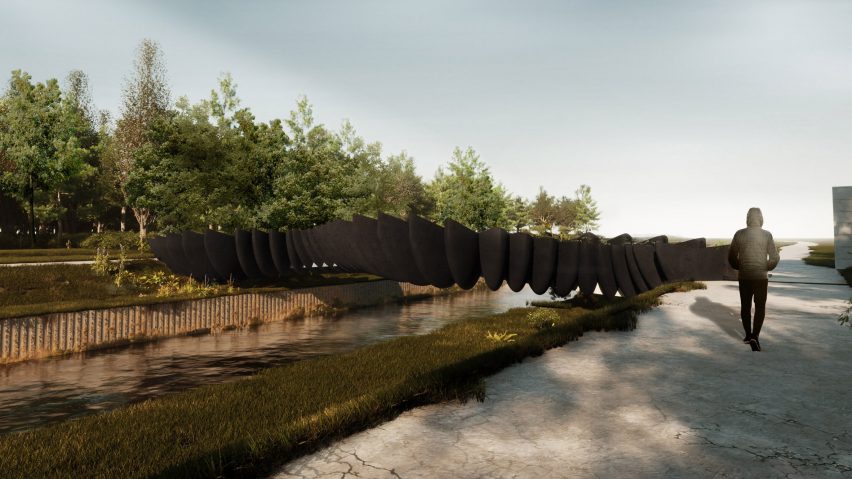A series of boat-like forms will be tied together to create the Asiat-Darse pedestrian bridge, which South African architect Sumayya Vally is designing for Vilvoorde in Belgium.
Vally, who is the founder of the architecture studio Counterspace, developed the design as a homage to the Congolese agriculturist Paul Panda Farnana, who once lived in the city.
She described Farnana as "one of the most important, yet least acknowledged figures of the city", who "epitomises the region's complex relationships with past and future generations of migrant bodies and communities".
"I was deeply moved to uncover the story of Paul Panda Farnana through our research, which then drove our response to the city's brief for a pedestrian bridge," said Vally.
"Trained as a horticulturist at the Vilvoorde Horticultural School not far from the site, this project will revive Farnana's legacy by foregrounding the concept on the species explored in his research, alongside water architectures from the Congo," she continued.
"It is my hope that this project helps to embody and raise awareness on the story of Farnana, and that it reminds us as architects that we have to listen deeply to the grounds of the contexts we work in. There is always architecture waiting to happen in places that are overlooked."
The Asiat-Darse bridge, which was selected as the winning entry of a competition held by the city, was designed by Vally in collaboration with engineering studio AKT II.
Her starting point for its sculptural form was "the water architectures of the Congo", specifically dugout canoes that typically line the banks of the Congo River.
"As a collective, they form a communal platform, from which trading and gathering can take place," Vally explained.
"These images form the basis for the proposed Asiat-Darse bridge, itself a place of gathering of travellers, whether commuters or visitors."
A series of curved, boat-like forms will be tied together to form the bridge's undulating structure, punctured by a flat platform for the walkway. Each individual structure will double as planters, nodding to Farnana's work and encouraging "seeds to be spread on the wind".
Alongside the Asiat-Darse bridge, Valley has designed a collection of smaller boat-like structures for sites along the river bank.
These will also be filled with plants with the aim of helping to pollinate and brighten the surrounding landscape. They will be named after Congolese labourers discovered during project research.
"When we were approached to work on the bridge and subsequently found the story of Farnana through our research, I was interested in the idea of this as an active monument and a space for healing and remembering," said Vally.
"This is translated into the story of the project, its form, and embodying Farnana's research. It is also embodied ecologically in how the scheme expands beyond the bridge to the broader ecosystem in the form of smaller 'boats' that will pollinate the entire river bank."
Construction of the Asiat-Darse bridge is planned to begin in April 2024, with completion scheduled for December 2025.
Elsewhere, Vally is currently developing exhibitions for a library in Monrovia being created by Niger-based Atelier Masōmī. She was also recently artistic director of the first Islamic Arts Biennale in Jeddah, Saudi Arabia.
The visuals are courtesy of Counterspace.

